The climate plays a main role, both in the vital activity of individual people, and in the formation, development and death of entire human civilizations. According to the data developed by scientists of the world, and as a result of the UN Commission studies, the world average temperature by 2025 will increase by 1.4-1.8 degrees Celsius. Having regard to the increasing influence of mankind on climate change, the Intergovernmental Panel on Climate Change (IPCC) is doing everything possible to increase the number of observations to create a more complete picture of global warming. Conclusions of specialists are disappointing.
They think that negative heating results will be felt everywhere [2, 15, 16]. The grain yields will seriously fall, the amount of available drinking water will decrease. Precipitation will fall out less and less. For Azerbaijan, this problem is also extremely urgent, since most of the wheat areas is in the zones of risky farming and is subject to a permanent negative impact of environmental conditions, resulting in the loss of more than half of the crop. Studies have shown that an increase in the average temperature in 2020-2050 in Azerbaijan, according to experts, will be 2.5 degrees higher. This will have a negative impact on many spheres of life. As an example, experts led the forecast of ecologists that the level of the Caspian Sea will increase by 150 cm until 2040, and this will create a tense situation. To mitigate the consequences of temperature increase in Azerbaijan, domestic specialists, together with representatives of international organizations and the national academy of sciences, are working on a strategic plan for adaptation to global warming [2, 9, 13]. If one has the mind of an annual population growth and an increase in stress factors in the near future, our republic may feel a shortage of grain and other food products.To mitigate the consequences of temperature increase in Azerbaijan, local specialists, together with representatives of international organizations and the national academy of sciences, are working on a strategic plan for adaptation to global warming [2, 9, 13, 14]. If one bears in mind annual population growth and an increase in stress factors in the near future, our republic may feel a shortage of grain and other food products.
Therefore, it is necessary to increase the total yields of food crops, as well as to create new stress-resistant, high-yielding varieties, to improve and spread the existing species and varieties of wheat that have been created by nature, people and through selection for rational use of their benefit for humanity [1, 2, 9,10, 11]. An important task of scientists is to identify drought-resistant genotypes of agricultural crops and to study the molecular genetic bases of resistance.
Materials and methods of research
The most important task in the field of agricultural crops is to ensure the stability of high yields under unfavorable environmental conditions. Materials of our research were 6 samples of soft wheat T. aestivum L. This is Saratovskaya 29, Fin-bugdasi, Dag-Dash Yaa 15662, Lutescens 2656, Seri -82, Ferruhineum 0 704/2.
Determination of drought and heat resistance in samples of soft wheat T. aestivum L. in laboratory conditions by physiological parameters. The determination of the drought resistance of wheat during the shoot period was carried out by two methods: according to the ability of the seeds to germinate under physiological moisture deficiency (such conditions were created in a saccharose solution at an osmotic pressure of 16 atm.); on the heat resistance of the embryo, which was determined on the basis of the evaluation of the germination of seeds after their heating in a water thermostat for 25 minutes at a temperature of 54-550 °C [3, 4, 8].
Further research has led to the identification of nucleic acids in the nucleic genome under the pressure of stress and treatment of their phytohormones.
In order to explain the evaluation of the genome and its functional activity, there is a deficit of moisture by PEG-3000 support. Seeds were germinated in Petri dishes, after their growth reached 6 cm, one part of the seedlings was taken as a control variant, and the remainder was subjected to stress with PEG (30 mg / 500 ml).After the 24th day of the week, each version was taken on 2gr leaves. The stain was scrubbed with water and dried out with PEG, but one part was added to the water, and the other was treated with phytohormones (gibberellin 50ml / lt). After a 48-hour treatment, the probe was investigated [5, 6].
Then the leaves were washed with water and dried in the PEG variant, one part was put back into the water, the other was treated with a complex of phytohormones (gibberellin 50 ml / Lt). the samples were taken after 48 hours of exposure [5, 6].
Results of research and their discussion
As can be seen from the data in Fig. 1: 3 of the 6 samples of soft wheat, T. aestivum L. were resistant. These are Saratovskaya 29, Fin-bugdasi, Dag-Dash Yaa 15662. At the Saratovskaya 29 sample, in comparison with the control variant, the germination of seeds in the osmotic solution was of 88 % and the percentage of seed germination after heating was 91 %. The next sample included in the group of highly resistant ones was the Fin-bugdasi in the conditions of water deficiency, the percentage of its seed germination was 80 %, and the percentage of seed germination after warming up was 75 %, Dag-Dash Yaa 15662 sample seeds germination in physiological drought conditions was 79 %, after heating was 81 %. Thus, in wheat samples, the percentage of germination of seeds in the sacharose solution varies from 75 % or more, we are conditionally evaluated them as drought-resistant. The ability of the seeds to germinate under these conditions reflects both the hereditary property of germinating with a relatively smaller amount of water, with the presence of a high suction force, ensuring rapid absorption of the required amount of water.
A relatively low percentage of seed germination was found in Lutescens 2656, Seri 82, Ferrugineum 0 704/2, where the percentage of seed germination varied in the amplitude of 26-45 %. For example: Lutescens 2656 seed germination under water deficiency conditions – 26 %, after heating 41 %, Seri 82 % seed germination in osmotic solution was -42 % and after seed-45 %, Ferrugineum 0 704 / 2- in sacharose solution 41 %, after heating-45 %. In these experiments, differences in seed germination energy were also observed in varieties with different degrees of resistance. In the seeds that were included in group 1, the major of the seeds germination 2 days after the experiment was laid. In medium-resistant and weakly resistant germination, the germination was extended for 4-5 days.
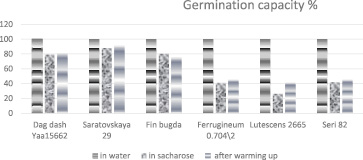
Fig. 1. Characterization of seed germination in sacharose solution, after warming up
As can be seen, in drought-resistant wheat varieties the percentage of germinated seeds is higher than non-resistant samples to drought. The high suction power of seeds causes not only better germination with a lack of moisture, but also the formation of a more powerful root system, which is important for the further vital activity of plants, especially with continuing drought.
Our research we continued on the study of changes occurring in the nuclear genome. 2 of 6 samples of soft wheat, T. aestivum L, were taken; resistant Doug Dash Yaa 15662, and weakly resistant Ferruguineum 0 704/2 on which the changes taking place in DNA fractions and the amount of RNA were determined under the influence of the stress factor and the action of a complex of phytohormones on them.
Thus, following the changes in the activity of the cell genome, we tried to find out the mechanism of adaptation to drought in the studied varieties. Essentially, the role of the structural state of DNA, on which adaptive reactions of the organism depend, is high. The data we obtained have been presented in Tables 1-2, and fig. 2.
As we can see from the data of the table, significant changes in the genome occur in the resistant variety Dag-Dash Yaa-15662 under the influence of stress, that is, an increase in the content of all fractions of DNA and RNA occurs. The amount of RNA increases by 9 %. The relative content of DNA shows an increase in the labile fraction, where the content reaches 37 %, the content of the stable fraction is 33 %, the residual fraction – 11 % and the total is 37 %.
We pay special attention to the change in the structural and functional condition of the genome, which is reflected in the active synthesis of labile DNA. The study of the fractional DNA composition showed that, in comparison with the control, the content of the labile active fraction of DNA was significantly increased, that is, under stress, the transcription activity of DNA increased. In addition, intensive RNA synthesis occurs, showing significant changes in the functional state of chromatin, which are directly related to genome activity [4–6, 16]. Since the predominant part of the labile DNA fraction is localized in euchromatin, which has a high functional activity. An increase in the content of this fraction appears to reflect an increase in the intensity of transcription and, accordingly, causes an increase in protein synthesis. The increase in total DNA in wheat germ cells may result from the amplification of DNA or endopliploidy, more likely as a result of a combination of both processes [5–7, 11, 13, 15].
After 48 hours of stress and treatment with phytohormones, the increase in RNA was 14 %, the labile DNA fraction was 69 %, the stable fraction was 65 %, the residual fraction was 13 %, and the total fraction was 63 %. From the literature it is known that the action of phytohormones contributes to the regeneration of the structural and functional state of the genome, disturbed by the impact of stress.
An increase in the content of nucleic acids in plant cells after treatment with phytohormones indicates that the regeneration processes are amplified and the genome becomes functionally active.
We also monitored the changes in the content of nucleic acids in the fractional DNA composition and the amount of RNA after stress on the weakly resistant variety, Ferugineum 0704/2 (Table 2) and Fig. 3.
Table 1
The content of DNA and RNA fractions on sprouts of Dag-Dash Yaa-15662 variety under drought and phytohormones effect (100 g wet weight in mkg)
|
Variants |
RNA |
DNA FRACTION |
Total DNA |
||
|
Labile |
Stabile |
Residual |
|||
|
Control |
170,0 ± 3,7 |
18,79 ± 0,41 |
14,89 ± 0,56 |
2,60 ± 0,31 |
36,28 ± 1,86 |
|
PEG (24 hours stress) |
186,0 ± 4,8 |
25,90 ± 0,79 |
19,85 ± 0,95 |
2,90 ± 0,51 |
49,71 ± 1,99 |
|
PEG + Н2О(24 hours) |
169,0 ± 3,8 |
18,08 ± 0,81 |
13,81 ± 0,36 |
2,95 ± 0,51 |
34,84 ± 1,86 |
|
PEG+kinetin-gibberellin (48 hours) |
193,0 ± 5,9 |
30,62 ± 1,82 |
22,87 ± 0,68 |
3,35 ± 0,96 |
56,84 ± 2,91 |
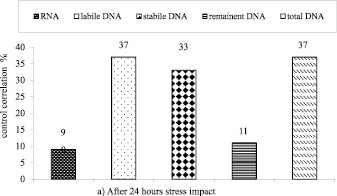
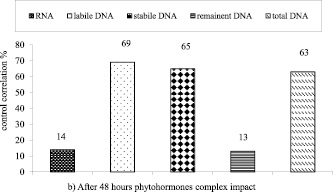
Fig. 2. Diagram of nuclein acids content in variety of Dag-Dash Yaa-15662 under stress and complex phytohormones impact (control correlation)
According to physiological parameters, the weakly resistant variety of Ferugineum 0704/2 shows a sharp decrease in both RNA and DNA content. The amount of RNA reduces by 7 %, the labile fraction by 25 %, the stable fraction by 5 %, the residual by 25 % and the total by 11 %. This indicates that under the influence of stress, the activity of heterochromatin increases, that is, a significant portion of the labile DNA is converted to a stable, less active state, characterized by a relatively low intensity of RNA synthesis and weak morphogenetic activity of the cells [1, 7]. In the cultivar Ferugineum 0704/2, phytohormones contributed to an increase in the content of nucleic acids. RNA increased by 17 %, labile DNA fraction by 25 %, stable by 23 %, residual by 11 %, total by 23 %.
Conclusions
Returning to our data, it can be said that a decrease in the functional activity of nucleic acids is a protective-adaptive reaction that allows the transition of metabolism to a new stable level. The experimental material obtained by us indicates that phytohormones display a significant effect on the genetic apparatus of the cell. The data of our studies give the reason to believe that resistance to drought is interrelated with structural and functional changes in the genome, as a sharp increase in the labile is occurring, i.e. genetically activated chromatin DNA and RNA in resistant varieties and forms [1, 3, 4, 7, 12–14]. As a result, the synthesis of the stress protein increases and the plant develops a protective-adaptive response, while for the weakly resistant varieties, the inverse process occurs. The reason for reducing the RNA content is probably the suppression of its synthesis as a result of a decrease in the functional activity of nuclear DNA and the plant weakens or dies. The experimental data obtained by us can be useful in studying the molecular genetic mechanisms of resistance to stress factors.
Тable 2
The content of DNA and RNA fractions in plants of the Ferrugineum variety 0 704/2 under the influence of drought and post-treatment by phytohormones (100 g wet weight in mkg)
|
Experimental versions |
RNA |
DNA fraction |
Total DNA |
||
|
labile |
stabile |
residual |
|||
|
Control |
96,60 ± 0,96 |
13,11 ± 0,21 |
15,03 ± 0,22 |
1,86 ± 0,20 |
30,00 ± 2,85 |
|
PEG(24 hours stress) |
90,00 ± 0,92 |
9,75 ± 0,19 |
14,30 ± 0,24 |
1,39 ± 0,25 |
25,44 ± 2,22 |
|
PEG + Н2О (24 hours) |
78,20 ± 0,59 |
12,40 ± 0,25 |
13,80 ± 0,26 |
1,35 ± 0,68 |
27,53 ± 2,33 |
|
PEG + kinetin-gibberelline (48 hours) |
91,80 ± 0,97 |
15,55 ± 0,38 |
17,00 ± 0,68 |
1,50 ± 0,59 |
34,05 ± 3,30 |
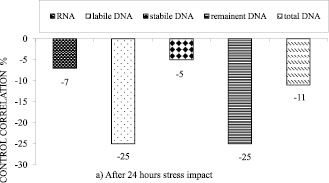
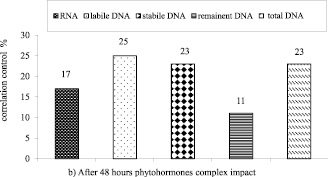
Fig. 3. Diagram of nuclein acids content in variety of Ferrugineum 0704/2 under stress and complex phytohormones impact (control correlation)

